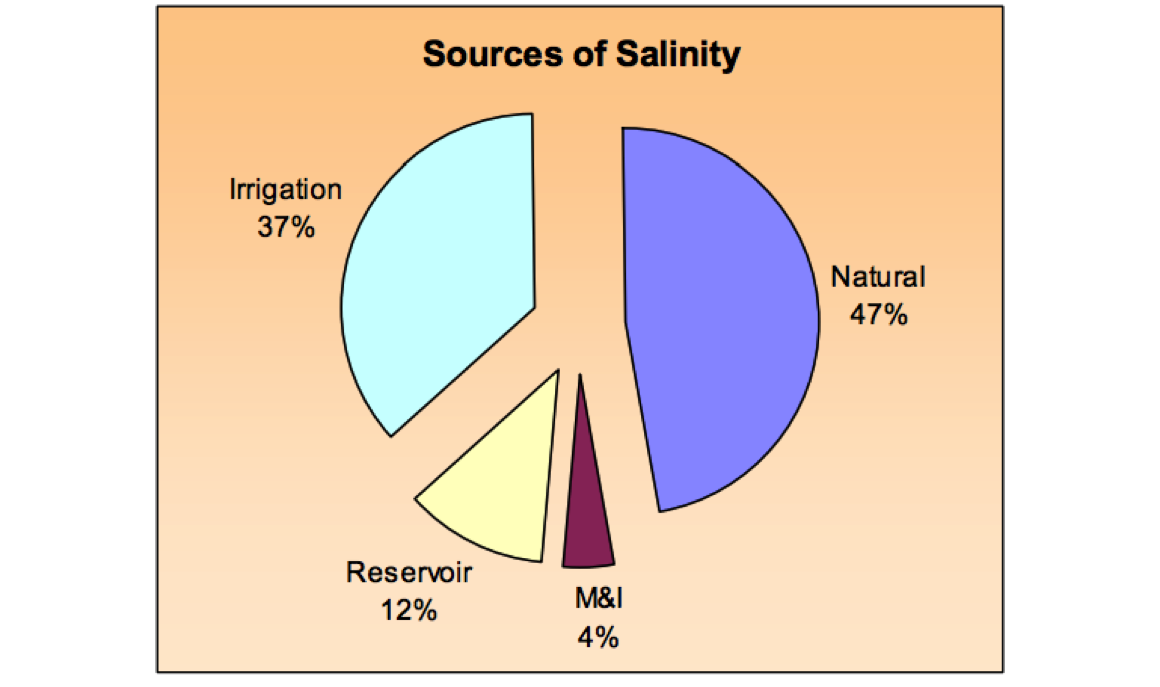Based on “Salinity in the Colorado River Basin, or, everything you never knew you didn’t know about salt.” A presentation by Natalie Popovich.
Salt is a substance so commonplace and (apparently) unremarkable that most people do not consider how often they interact with this mineral in their daily lives. Whether seawater stings the eyes of a beach-goer in California, someone asks for the salt shaker at the dinner table, or a Wisconsinite spreads salt pellets in their driveway after a snow— everybody knows salt, for one reason or another, for one purpose or another. Although a lot of people know what salt can do for them, not everyone is aware of how their daily actions, and human activity in general, impact the balance of salt in the natural environment. Nowhere is this more evident than when considering how human activities affect salinity in the Colorado River Basin.
The drainage basin of the Colorado River comprises an area of approximately 246,000 square miles across the southwestern United States, including Arizona, California, Colorado, Nevada, New Mexico, Utah, and Wyoming (USGS, 2014). The Colorado River has been regulated extensively for a variety of uses: to supply water to over 30 million residents of the southwest, to irrigate approximately 4 million acres of agricultural land, and to generate power using hydroelectric dams (10 billion kilowatt-hours per year) (USGS, 2014).
The largest of these hydroelectric dams on the Colorado River is Hoover Dam, which created Lake Mead in 1935 when construction was completed. Lake Mead now receives approximately 9 million tons of salt each year from the Colorado River, upstream of the dam. But where does this salt come from? And why is there so much salt in the Colorado River basin? What have humans done to generate large scale salt deposition in the Colorado River?
According to the United States Bureau of Reclamation, salinity in the Colorado River basin comes from a variety of sources. The principal origin of salt is from natural sources (47%) that include saline springs, erosion of saline geologic formations, runoff from rainfall and snowmelt, and simple stream flow. All of these processes naturally pick up salt contained in soils and rocks and later deposit them downstream. The major human sources of salt in the Colorado drainage basin comprise agricultural irrigation (37%), reservoir storage (12%), and municipal and industrial uses (4%) that include salinity control programs.

The irrigated farmland that most affects the Colorado River includes approximately 1.7 million acres that are located in the upper basin. Water used for irrigation dissolves salts in underlying soils, which later crystalizes close to the surface when water is removed via evapotranspiration (Laituri and Sternlieb). Evapotranspiration is the process through which water moves from the land to the atmosphere by direct evaporation from soils and transpiration (release of water) from plants. The irrigation process described above accounts for about 37%, or 3.4 million tons, of salt input into the Colorado drainage basin per year. Reservoir storage, which accounts for 12%, occurs when high-salinity water stored behind dams is released during periods of high flow. Municipal and industrial projects, such as water from mining practices comprise the final 4% of salt input into the Colorado drainage basin.
But why is this important? Why should anyone care?
The United States Bureau of Reclamation estimated that the salt levels present in the Colorado River in 2010 caused $295 million dollars of damage. This salinity damage model estimates damages sustained by the Lower Colorado River basin from salinized water received from the Upper Colorado River basin. Examples of damage include reduced crop production and corroded or plugged pipes.


The United States government, as well as other, smaller scale projects, has worked towards reducing the salinity of the Colorado River. Solutions include canal lining, protective and regulatory pumping, desalination plants, road improvements, environmental restoration, and silt traps. Although great efforts have been made towards improving this human induced problem, some of these salinity control options have their own set of drawbacks. For example, the Yuma Desalination Plant in Arizona can reclaim (desalinate) 108,000 acre-feet of water of saline drainage per year. However, this process increased the salinity of the Cienega Wetlands Habitat adjacent to the plant and lead to controversy surrounding the efficacy of the plant. The Yuma plant is not currently in operation and would need significant upgrades in order to be effective (and environmentally friendly) in the long-term.
From the irrigation of land that supplies food to the use of salt on icy roadways, it is important to take note of the fact that there are far-reaching economic and environmental impacts of the infrastructure that many people use on a daily basis. And remember: ask not what salt can do for you, but what you can do for salt (in the Colorado River).
Sources:
https://www.usbr.gov/uc/progact/salinity/pdfs/PR22.pdf
http://www.crbagwater.colostate.edu/files/mapping-irrigated-ag-in-crb.pdf
http://www.usbr.gov/uc/progact/salinity/pdfs/PR24final.pdf
http://bestride.com/blog/prices-for-road-salt-have-doubled-since-last-wi...
http://west.stanford.edu/students/soco/yuma-desalination-plant
